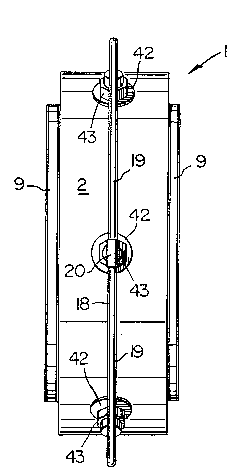Une partie des informations de ce site Web a été fournie par des sources externes. Le gouvernement du Canada n'assume aucune responsabilité concernant la précision, l'actualité ou la fiabilité des informations fournies par les sources externes. Les utilisateurs qui désirent employer cette information devraient consulter directement la source des informations. Le contenu fourni par les sources externes n'est pas assujetti aux exigences sur les langues officielles, la protection des renseignements personnels et l'accessibilité.
L'apparition de différences dans le texte et l'image des Revendications et de l'Abrégé dépend du moment auquel le document est publié. Les textes des Revendications et de l'Abrégé sont affichés :
| (12) Brevet: | (11) CA 2015638 |
|---|---|
| (54) Titre français: | APPAREIL DE CHAUFFAGE CATALYTIQUE |
| (54) Titre anglais: | CATALYTIC HEATER |
| Statut: | Durée expirée - au-delà du délai suivant l'octroi |
| (51) Classification internationale des brevets (CIB): |
|
|---|---|
| (72) Inventeurs : |
|
| (73) Titulaires : |
|
| (71) Demandeurs : |
|
| (74) Agent: | GOWLING WLG (CANADA) LLP |
| (74) Co-agent: | |
| (45) Délivré: | 1995-11-14 |
| (22) Date de dépôt: | 1990-04-27 |
| (41) Mise à la disponibilité du public: | 1991-10-27 |
| Requête d'examen: | 1993-03-22 |
| Licence disponible: | S.O. |
| Cédé au domaine public: | S.O. |
| (25) Langue des documents déposés: | Anglais |
| Traité de coopération en matière de brevets (PCT): | Non |
|---|
| (30) Données de priorité de la demande: | S.O. |
|---|
In general, catalytic heaters which rely on ambient
air for operation are self limiting. A simple, effective
solution to the problem includes a casing with an open front
end, a screen on such front end, a catalyst pad in the casing
behind the screen, and diffuser pads for receiving a gas/air
fuel mixture from a mixer which creates the mixture and
introduces the mixture through the rear wall of the casing.
Channels or dikes in the diffuser pads ensure even
distribution of the gas/air fuel mixture to the catalyst pad.
Note : Les revendications sont présentées dans la langue officielle dans laquelle elles ont été soumises.
Note : Les descriptions sont présentées dans la langue officielle dans laquelle elles ont été soumises.

2024-08-01 : Dans le cadre de la transition vers les Brevets de nouvelle génération (BNG), la base de données sur les brevets canadiens (BDBC) contient désormais un Historique d'événement plus détaillé, qui reproduit le Journal des événements de notre nouvelle solution interne.
Veuillez noter que les événements débutant par « Inactive : » se réfèrent à des événements qui ne sont plus utilisés dans notre nouvelle solution interne.
Pour une meilleure compréhension de l'état de la demande ou brevet qui figure sur cette page, la rubrique Mise en garde , et les descriptions de Brevet , Historique d'événement , Taxes périodiques et Historique des paiements devraient être consultées.
| Description | Date |
|---|---|
| Inactive : Périmé (brevet - nouvelle loi) | 2010-04-27 |
| Inactive : CIB de MCD | 2006-03-11 |
| Lettre envoyée | 2002-03-05 |
| Inactive : Grandeur de l'entité changée | 2002-02-14 |
| Inactive : TME en retard traitée | 2002-01-31 |
| Lettre envoyée | 2001-04-27 |
| Accordé par délivrance | 1995-11-14 |
| Exigences pour une requête d'examen - jugée conforme | 1993-03-22 |
| Toutes les exigences pour l'examen - jugée conforme | 1993-03-22 |
| Demande publiée (accessible au public) | 1991-10-27 |
Il n'y a pas d'historique d'abandonnement
| Type de taxes | Anniversaire | Échéance | Date payée |
|---|---|---|---|
| TM (brevet, 8e anniv.) - petite | 1998-04-27 | 1998-01-27 | |
| TM (brevet, 9e anniv.) - petite | 1999-04-27 | 1999-01-08 | |
| TM (brevet, 10e anniv.) - petite | 2000-04-27 | 2000-02-18 | |
| TM (brevet, 11e anniv.) - générale | 2001-04-27 | 2001-03-27 | |
| Annulation de la péremption réputée | 2001-04-27 | 2001-03-27 | |
| Enregistrement d'un document | 2002-01-28 | ||
| TM (brevet, 12e anniv.) - générale | 2002-04-29 | 2002-04-23 | |
| TM (brevet, 13e anniv.) - générale | 2003-04-28 | 2003-04-25 | |
| TM (brevet, 14e anniv.) - générale | 2004-04-27 | 2004-04-22 | |
| TM (brevet, 15e anniv.) - générale | 2005-04-27 | 2005-04-14 | |
| TM (brevet, 16e anniv.) - générale | 2006-04-27 | 2006-04-24 | |
| TM (brevet, 17e anniv.) - générale | 2007-04-27 | 2007-03-19 | |
| TM (brevet, 18e anniv.) - générale | 2008-04-28 | 2008-03-06 | |
| TM (brevet, 19e anniv.) - générale | 2009-04-27 | 2009-03-27 |
Les titulaires actuels et antérieures au dossier sont affichés en ordre alphabétique.
| Titulaires actuels au dossier |
|---|
| CCI THERMAL TECHNOLOGIES INC. |
| Titulaires antérieures au dossier |
|---|
| ALAN KIRBY |